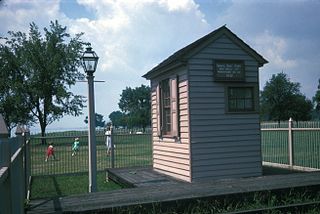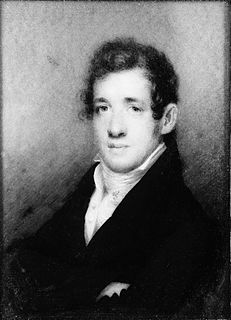Related Research Articles

Port Deposit is a town in Cecil County, Maryland, United States. It is located on the east bank of the Susquehanna River near its discharge into the Chesapeake Bay. The population was 653 at the 2010 census.

The second USS Pennsylvania (ACR-4/CA-4), also referred to as Armored Cruiser No. 4, and later renamed Pittsburgh, was a United States Navy armored cruiser, the lead ship of her class. She was originally assigned the name Nebraska but was renamed Pennsylvania on 7 March 1901.

The Baltimore and Ohio Railroad was the first common carrier railroad and the oldest railroad in the United States, with its first section opening in 1830. Merchants from the city of Baltimore, which had benefitted to some extent from the construction of the National Road early in the century, wanted to continue to compete for trade with trans-Appalachian settlers with the newly constructed Erie Canal, another canal being proposed by Pennsylvania, the Chesapeake and Ohio Canal, and the James River Canal, which directed traffic toward Richmond and Norfolk, Virginia. At first the B&O was located entirely in the state of Maryland, its original line extending from the port of Baltimore west to Sandy Hook. There it connected with Harper's Ferry across the Potomac into Virginia, and also with the navigable Shenandoah River.

John Edgar Thomson was an American civil engineer and industrialist. An entrepreneur best known for his leadership of the Pennsylvania Railroad (PRR) from 1852 until his death in 1874, Thomson made it the largest business enterprise in the world and a world-class model for technological and managerial innovation. The railroad's first Chief Engineer became its third President.

The Baltimore and Potomac Railroad (B&P) operated from Baltimore, Maryland, southwest to Washington, D.C., from 1872 to 1902. Controlled by the Pennsylvania Railroad, it was the second railroad company to connect the nation's capital to the Northeastern States, and competed with the older Baltimore & Ohio Railroad.

The New Castle and Frenchtown Turnpike and Rail Road (NC&F) was opened in 1831, was the first railroad in Delaware and one of the first in the United States. About half of the route was abandoned in 1859; the rest became part of the Pennsylvania Railroad (PRR) route into the Delmarva Peninsula and is still used by Norfolk Southern Railway. The abandoned segment from Porter, Delaware, to Frenchtown, Maryland, the New Castle and Frenchtown Railroad Right-of-Way, was listed on the National Register of Historic Places in 1976.

The Philadelphia, Wilmington and Baltimore Railroad (PW&B) was an American railroad company itself a result of merger of four small lines dating from the earliest days of American railroading in the late 1820s and early 1830s, that operated from 1836, until being bought by a larger regional line in 1881, with a merger into a longer Northeast Corridor railway in 1902. It built the first rail line south from Philadelphia into The South.

The Northern Central Railway (NCRY) was a Class I Railroad connecting Baltimore, Maryland with Sunbury, Pennsylvania, along the Susquehanna River. Completed in 1858, the line came under the control of the Pennsylvania Railroad (PRR) in 1861, when the PRR acquired a controlling interest in the Northern Central's stock to compete with the rival Baltimore and Ohio Railroad (B&O). For eleven decades the Northern Central operated as a subsidiary of the PRR until much of its Maryland trackage was washed out by Hurricane Agnes in 1972; after which most of its operations ceased as the Penn Central declined to repair sections. It is now a fallen flag railway, having come under the control of the later Penn Central, Conrail, and then broken apart and disestablished. The southern part in Pennsylvania is now the York County Heritage Rail Trail which connects to a similar hike/bike trail in Northern Maryland down to Baltimore, named the Torrey C. Brown Rail Trail. Only the trackage around Baltimore remains in rail service.
Benjamin Henry Latrobe II was an American civil engineer, best known for his railway bridges, and a railway executive.

The Newkirk Viaduct Monument is a 15-foot white marble obelisk in the West Philadelphia neighborhood of Philadelphia, Pennsylvania. Installed in 1839, it is inscribed with the names of 51 railroad builders and executives, among other information.

The Philadelphia, Baltimore and Washington Railroad (PB&W) was a railroad that operated in Pennsylvania, Delaware, Maryland, and the District of Columbia in the 20th century, and was a key component of the Pennsylvania Railroad (PRR) system. Its 131-mile (211 km) main line ran from Philadelphia to Washington. The PB&W main line is now part of the Northeast Corridor, owned by Amtrak.

The Columbia and Port Deposit Railroad (C&PD) was a railroad that operated in Pennsylvania and Maryland in the 19th and early 20th centuries. It operated a 34-mile long (55 km) main line between Columbia, Pennsylvania, and Port Deposit, Maryland, generally along the eastern shore of the Susquehanna River. It later acquired a branch line to Perryville, Maryland. The C&PD was subsequently purchased by the Pennsylvania Railroad (PRR) and, since the 1996 breakup of Conrail, is owned by Norfolk Southern Railway.
Brantz Mayer was an American author, lawyer, and historian.
Jacob I. Cohen Jr. was a banker, railroad executive, and civic leader who helped win for Jews the right to hold public office in Maryland.
Roswell Lyman Colt (1779-1856) was an American businessman who made a fortune in the shipping industry, served for decades as governor of the Society for Establishing Useful Manufactures, and was an early railroad executive.
Herman Joseph Lombaert (1816–1885) was an American civil engineer who helped complete the first railroad between Philadelphia, Pennsylvania, and Baltimore, Maryland, and eventually became a vice-president of the Pennsylvania Railroad (PRR).

Charles Frederick Mayer (1795-1864) was an American lawyer, Maryland state senator, and railroad director.
William Chandler was a 19th-century businessman based in Wilmington, Delaware, an active abolitionist, and an early railroad executive.
James Sewall (1778-1842) was a U.S. officer in the War of 1812, public servant, and early railroad executive.
Henry R. Hazlehurst (1815-1900) was an American civil engineer. Long employed by the Baltimore and Ohio Railroad, he also helped build the first rail link between Philadelphia, Pennsylvania, and points south.
References
- 1 2 3 4 Lowry, Patricia (August 10, 2008). "Young traveler's journal solves art show's Pittsburgh mystery". Pittsburgh, Pennsylvania. Pittsburgh Post-Gazette. Retrieved 22 July 2013.
- ↑ Jefferson, Thomas (March 11, 1809). "Thomas Jefferson to Mayer & Brantz, 11 March 1809". Founders Online. National Archives. Retrieved 22 July 2013.
- ↑ Wilson, William Bender (1895). History of the Pennsylvania Railroad Company with Plan of Organization, Portraits of Officials and Biographical Sketches. 1. Philadelphia: Henry T. Coates & Company. Retrieved November 25, 2012.
- ↑ "1838 (June 2004 Edition)" (PDF). PRR CHRONOLOGY. The Pennsylvania Railroad Technical & Historical Society. June 2004. p. 2. Retrieved 23 July 2013.